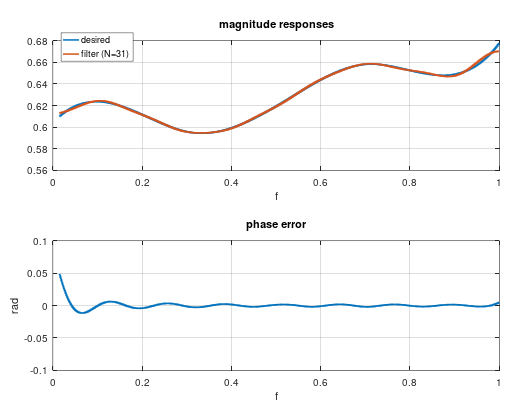I am having trouble when design FIR filter fitting to the complex data (i.e., amplitude and phase responses from measurements). I did try to use Matt. L's lslevin method here since this method is to deal with arbitrary prescribed amplitude and phase. However, it seems that I cannot get the appropriate real time-domain coefficients. You may run the Matlab script to check the results.
The issues I did encounter were that the amplitude and phase estimated from lslevin result present huge errors compared to the original measured data.
I have also checked with various design method listed in Matt. L. PhD thesis, but I still have not found a solution.
It would be great help if you have any suggestions or solutions.
Thank you very much.
Matlab script for illustration:
% FIR filter design using LS method with arbitrary amp. & phase resp.
% (nonlinear phase)
clc;close all;clear all
%% setups & measurement results
fs = 16e9;
fn = 31/4096*fs:125e6:2047/4096*fs;
f_norm = 2*pi*fn/fs;
fn_intp = linspace(f_norm(1),f_norm(end),512);
amp0 = [0.6100 0.6082 0.5949 0.6309 0.6582 0.6482 0.6775];
phs0 = [0.0465 0.0465 0.2740 0.8148 1.0403 1.8896 2.5158];
f_meas = [f_norm(1) f_norm(14) f_norm(20) f_norm(35) f_norm(45) f_norm(55) f_norm(end)];
% interpolation to have dense data
amp = interp1(f_meas,amp0,fn_intp,'spline');
phs = interp1(f_meas,phs0,fn_intp,'spline');
figure;plot(fn_intp,amp);figure;plot(fn_intp,phs);
%% Test with Matt. L.'s alg.
D = amp.*exp(1j*phs);% desired response
W = [ones(1,32) ones(1,448) ones(1,32)];% weighted
tap_num = 11;
h = lslevin(tap_num,fn_intp,D,W); % please download the lslevin function
figure;stem(h,'linewidth',2);grid on;xlabel('Index');ylabel('Amp.')
% plot to check
[A,F] = freqz(h,1,512);
figure;plot(fn_intp,amp);grid on
hold on;plot(F,abs(A));xlabel('Norm freq. (rad./sample)');ylabel('Amp.')
legend('Original','LS results')
figure;plot(fn_intp,phs);grid on
hold on;plot(F,angle(A));xlabel('Norm freq. (rad./sample)');ylabel('rad.')
legend('Original','LS results')


